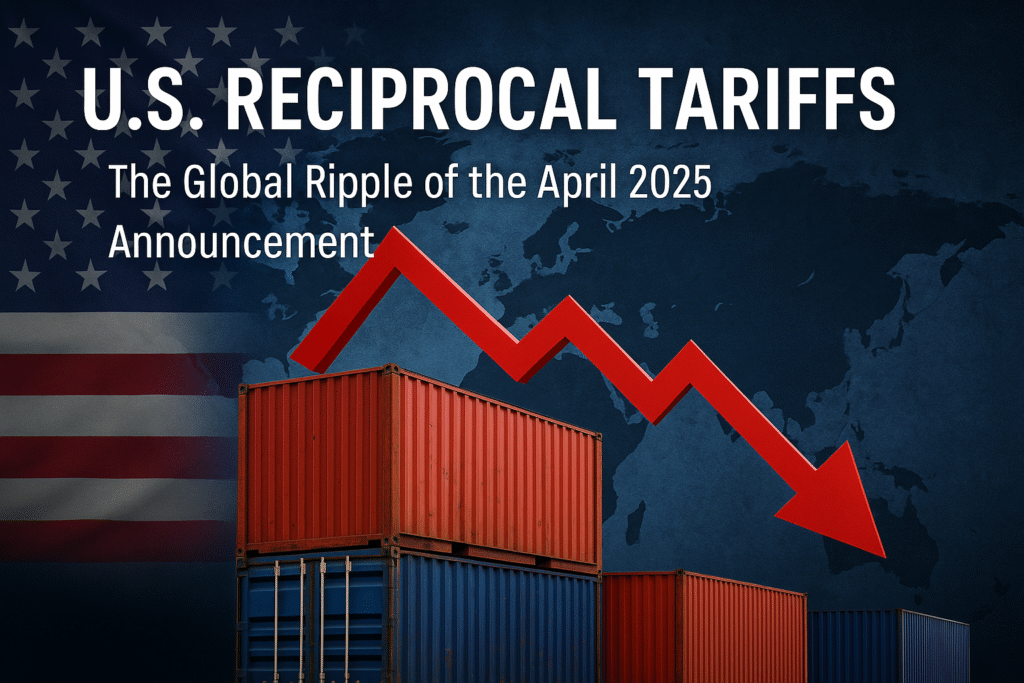On April 2, 2025, President Donald Trump stunned the global economic community by declaring what he termed “Liberation Day,” a bold pivot in U.S. trade policy. Through Executive Order 14257, the administration introduced a sweeping set of U.S. reciprocal tariffs—beginning with a universal 10% levy on most imported goods, followed by sharply higher, country-specific “reciprocal” tariffs designed to mirror and retaliate against what were deemed unfair trade practices.
This unprecedented move marked a dramatic return to economic nationalism, shaking the foundations of global trade and setting off a cascade of reactions from both allies and rivals. As nations scramble to respond, the world finds itself at a critical crossroads—one that could redefine not just the flow of goods, but the very principles of international cooperation and economic diplomacy.
📅 Timeline of Key Developments
- April 2: Announcement of a 10% baseline tariff on most imports, with higher rates for specific countries.
- April 5: Implementation of the 10% universal tariff.
- April 9: Higher reciprocal tariffs take effect, including a 34% additional tariff on Chinese goods, raising the total to 54%.
- April 10: China retaliates with a 34% tariff on all U.S. goods.
- April 11: The U.S. escalates tariffs on Chinese imports to 145%; China responds by increasing tariffs on U.S. goods to 125%.
📊 Tariff Rates Imposed
The U.S. reciprocal tariffs varied by country, reflecting the administration’s assessment of each nation’s trade practices:Wikipedia
- China: An initial 34% tariff, escalating to 145% after successive retaliations.
- Vietnam: 46%
- Sri Lanka: 44%
- Bangladesh: 37%
- Thailand: 36%
- Taiwan & Indonesia: 32%
- Switzerland: 31%
- South Africa: 30%
- Pakistan: 29%
- India: 26%
- South Korea: 25%
- Japan: 24%
- European Union: 20%
- Australia, UK, Singapore: 10%
- Canada & Mexico: Exempted due to existing trade agreements.
🌐 Global Responses
China: Beijing condemned the U.S. tariffs as economic coercion and responded with proportional tariffs on American goods. Additionally, China restricted exports of rare earth elements critical to various industries and warned other nations against aligning with U.S. trade policies at China’s expense.
European Union: The EU criticized the tariffs as unjustified and harmful to global economic stability, signaling intentions to implement retaliatory measures.
Other Nations: Countries like Japan and South Korea expressed deep concern, with Japan labeling the tariffs as “extremely regrettable.” Canada initiated legal action against the U.S., arguing the tariffs exceeded presidential authority and threatened its economy.
📉 Economic and Diplomatic Implications
Short-Term Effects:
- Market Volatility: Global stock markets experienced significant downturns, with the S&P 500 and Dow Jones Industrial Average recording substantial losses in the days following the tariff announcements.
- Trade Disruptions: The tariffs disrupted global supply chains, leading to increased costs for businesses and consumers.
Long-Term Consequences:
- Global Trade Realignment: The World Trade Organization projected a potential 0.8% decline in global goods trade for 2025, attributing the downturn to the U.S. tariff policies.
- Diplomatic Strains: The unilateral nature of the tariffs strained U.S. relations with key allies, prompting discussions of new trade alliances that exclude the U.S.
- Economic Uncertainty: The tariffs introduced significant uncertainty into the global economy, with businesses hesitant to invest amid unpredictable trade policies.
🔮 Future Outlook
The imposition of these sweeping tariffs by the United States represents more than just a policy shift—it signals a fundamental transformation in how the world’s largest economy intends to engage with global trade. By adopting a highly protectionist stance, the U.S. has moved away from decades of multilateralism, challenging the very framework upon which modern international trade has been built, including institutions like the World Trade Organization (WTO).
This pivot could reshape global economic alliances. Nations previously reliant on U.S. markets are now exploring regional trade partnerships and strengthening economic ties with emerging powers like China, India, and regional blocs such as the European Union, ASEAN, and the African Continental Free Trade Area (AfCFTA). We may witness an acceleration of trade diversification strategies as countries seek to reduce dependency on the American market to avoid vulnerability to sudden policy shifts.
In the short term, this policy has already led to retaliatory measures, disruption of supply chains, inflationary pressures, and increased volatility in global markets. As countries respond with their own tariffs, non-tariff barriers, or currency adjustments, the risk of a full-blown trade war remains high. Businesses and investors face heightened uncertainty, which could slow capital flows, discourage foreign direct investment, and stall industrial recovery post-pandemic.
Diplomatically, the unilateral nature of the tariffs has frayed ties with long-standing allies, many of whom view the move as an act of economic aggression rather than strategic policy. Trust deficits may lead to long-term strategic realignments, with some countries pivoting more toward China’s Belt and Road Initiative or other regional frameworks as a counterbalance to U.S. assertiveness.
In the long run, if these divisions deepen, the world may transition into a multipolar trade system with fragmented blocs, each governed by different rules and standards. This could reduce global efficiency, increase transaction costs, and challenge the stability of the rules-based order. Alternatively, if cooler heads prevail, this period could serve as a catalyst for reforming global trade institutions to better reflect current geopolitical realities.
Ultimately, whether this tariff regime will mark the beginning of a new economic paradigm or a temporary disruption depends heavily on upcoming diplomatic engagements, the resilience of global institutions, and the political will to rebuild bridges amid rising economic nationalism.
